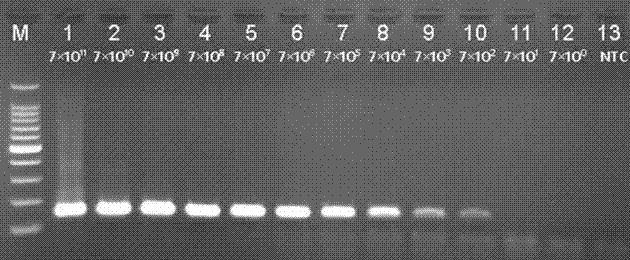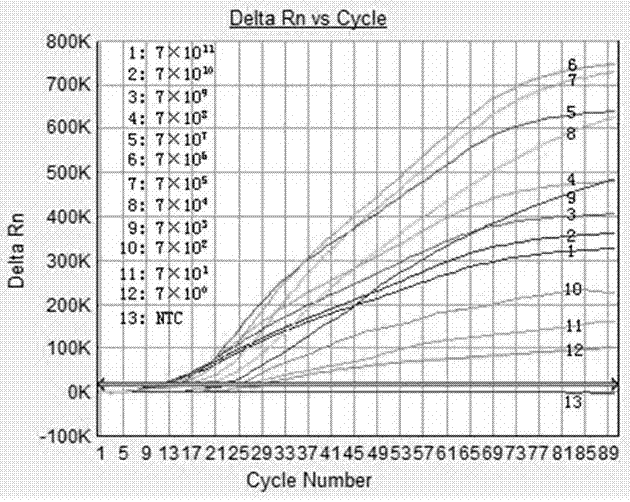Group A rotavirus real-time isothermal amplification detection kit, primers and probe thereof
A group A rotavirus, detection kit technology, applied in biochemical equipment and methods, recombinant DNA technology, microbial assay/inspection, etc. High efficiency and specificity
- Summary
- Abstract
- Description
- Claims
- Application Information
AI Technical Summary
Problems solved by technology
Method used
Image
Examples
Embodiment 1
[0031] Example 1: Design of real-time NASBA primers and probes
[0032] Rotaviruses are divided into different groups according to different serological responses, and each group can be divided into different serotypes. So far, seven rotavirus groups (groups A to G) have been reported. Group A rotavirus is the main pathogen of severe diarrhea in infants and young children. The rotavirus group antigen is determined by the VP6 gene, while the VP7 and VP4 genes determine the G and P serotypes, respectively. Therefore, selecting the highly conserved nucleic acid sequence of the VP6 gene as the target sequence for real-time NASBA primer and probe design is representative for the detection of group A rotaviruses. Firstly, 100 DNA sequences of group A rotavirus VP6 genes were downloaded from the gene bank of NCBI in the United States, and then the homologous comparison analysis was performed on the downloaded sequences using the molecular biology software DNAMAN 6.0 (Lynnon Corpo...
Embodiment 2
[0042] Example 2: Establishment and optimization of a real-time NASBA detection system for group A rotavirus
[0043] The conditions were optimized for some important influencing factors of the real-time NASBA detection system.
[0044] 1. Method
[0045] (1)K + Concentration: prepare 2× real-time NASBA reaction solution according to the reaction system in Table 1, fix other parameters, and adjust K respectively + The final concentration was 40mM, 60mM, 80mM, 100mM, 120mM, 240mM, and real-time NASBA isothermal amplification was performed using the in vitro transcribed RNA of group A rotavirus VP6 gene as a template. After the experiment, compare different K + Effect of concentration on amplification efficiency and fluorescence curve.
[0046] (2) Concentration combination of dNTP / NTP: Prepare 2× real-time NASBA reaction solution according to the reaction system in Table 1, fix other parameters, and adjust the final concentration of dNTP / NTP to 0.1mM / 1.6mM, 0.2mM / 1.6mM, 0...
Embodiment 3
[0051] Example 3: Composition and detection method of real-time NASBA kit for detecting group A rotavirus
[0052] 1. Composition of the kit (stored at -20°C)
[0053] (1) 2× real-time NASBA reaction solution: its components are: 120mM Tris-HCl (pH8.0), 240mM KCl, 20mM MgCl2, 24mM DTT, 4mM spermidine, 0.4mM dNTP, 3.2mM NTP, 0.3mM trehalose, 0.4mM Betaine, 30% DMSO, 0.8μM Forward Primer F1, 0.8μM Reverse Primer R1, 0.4μM Molecular Beacon Probe P1; wherein the forward primer F1 is the nucleus shown in SEQ ID NO:1 Nucleotide sequence, the reverse primer R1 is the nucleotide sequence shown in SEQ ID NO: 2, and the molecular beacon probe P1 is the nucleotide sequence shown in SEQ ID NO: 3;
[0054] (2) 5×enzyme mixture: its components are: 1.5 U / μL AMV reverse transcriptase, 6 U / μL T7 RNA transcriptase, 0.0625 U / μL RNAase H enzyme, 5 U / μL Ribonuclease Inhibitor, 20 mg / mL BSA, 8 mM sorbitol (sorbitol);
[0055] (3) Positive control: VP6 gene RNA fragment transcribed in vitro b...
PUM
 Login to View More
Login to View More Abstract
Description
Claims
Application Information
 Login to View More
Login to View More - R&D
- Intellectual Property
- Life Sciences
- Materials
- Tech Scout
- Unparalleled Data Quality
- Higher Quality Content
- 60% Fewer Hallucinations
Browse by: Latest US Patents, China's latest patents, Technical Efficacy Thesaurus, Application Domain, Technology Topic, Popular Technical Reports.
© 2025 PatSnap. All rights reserved.Legal|Privacy policy|Modern Slavery Act Transparency Statement|Sitemap|About US| Contact US: help@patsnap.com



